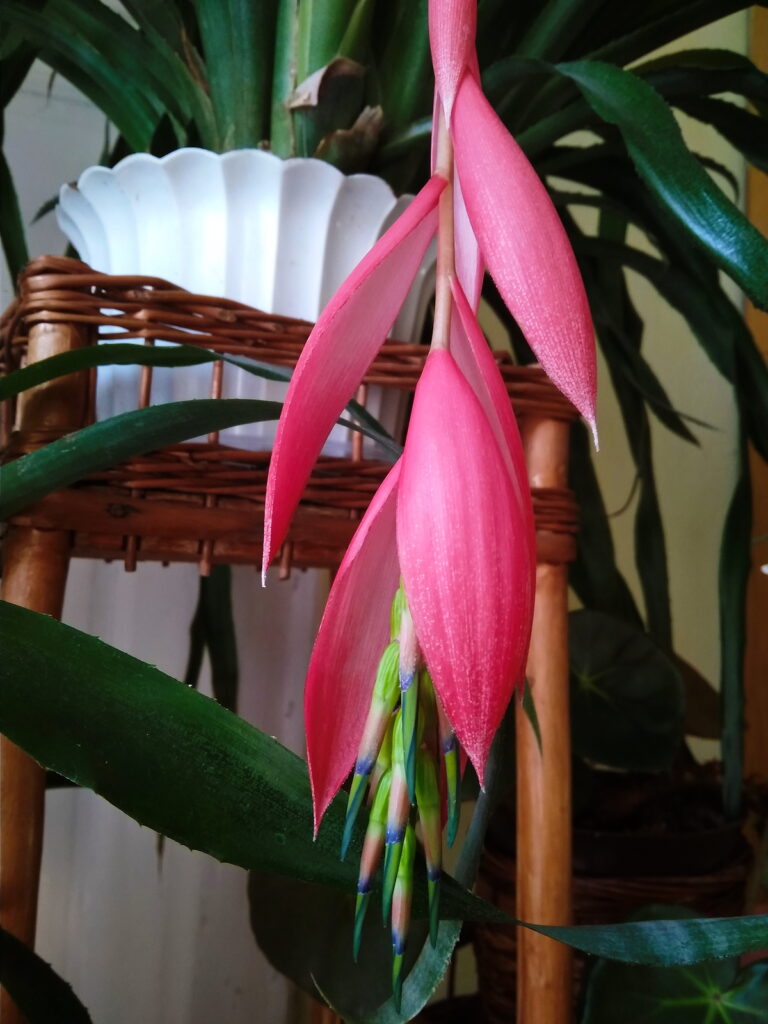Billbergia is a tree-dwelling (epiphytic) evergreen bromeliad that bears brightly colored tubular flowers surrounded by rose-pink bracts that dangle in clusters over rosettes of strap-shaped leaves. Flowers appear between spring and autumn and last for three to four weeks.
Billbergia has stiff multicolored leaves that form rosettes. The unusual tubular blooms appear erect on a spike or droop gracefully; they stay in bloom for several weeks,
Billbergia is commonly grown in containers for display indoors or on patios. In subtropical and tropical climates it can be grown under trees as a groundcover on the limbs of trees.
Billbergia is a genus of about 52 species of epiphytic evergreen plants. Billbergia is native to southern Mexico, Central America, and parts of South America.
Get to know Billbergia
- Plant type: Epiphytic evergreen perennial bromeliads
- Growing zones and range: Zones 9-15
- Hardiness: Hardy to Zone 9
- Temperature: Tolerates wide range of household temperatures.
- Height and width: 20 inches (50cm) tall and wide
- Foliage: Stiff, spiny-toothed leaves in basal clusters
- Flowers: Erect or arching panicles or racemes of showy bracts and tubular flowers that are short-lived flowers
- Bloom time: Summer
- Uses: Houseplant, tropical goarden
- Common name: Queen’s tears, vase plant
- Botanical name: Billbergia
- Family name: Bromeliaceae
- Origin: Southern Mexico, Central America, Northeast and Central South America

Where to plant Billbergia
- Light: Indoors grow Billbergia in filtered bright light, with 4 hours of direct sun in winter, from eastern or western exposure. Air circulation is important.
- Light: Outdoors grow Billbergia in partial shade.
- Soil: Grow Billbergia in an epiphytic bromeliad mix.
When to plant Billbergia
- Set Billbergia outdoors any time of the year in tropical and subtropical regions.
Planting and spacing Billbergia
- Space Billbergia 20 inches (50cm) apart.
How to water and feed Billbergia
- Water: Water Billbergia freely during the growing season. Let the soil dry moderately between thorough waterings. Keep fresh water in leaf cup when the plant is not flowering. Mist several times a week. Keep humidity at about 45% to 60%.
- Feeding: Feed Billbergia monthly, with mild liquid fertilizer. Avoid oil-based products such as fish emulsion. Spray on leaves, add to water in cup or apply to growing medium after watering; never fertilize a dry plant.
Billbergia care
- To lengthen the life of flowers, do not fill the leaf cup with water while in bloom.
- Billbergia dies within 2 years after flowering.
Growing Billbergia as a houseplant
- Grow Billbergia in a warm room with average humidity and direct light.
- The growing medium should be extra rich and well-drained; all the medium to dry out between waterings.
- Keep water in the cup at the base of the plant.
- Fertilize Billbergia monthly during spring and summer with quarter-strength liquid fertilizer.
Billbergia pests and diseases
- Check Billbergia for scale insects, mealybugs, and fungal leaf spots.
Billbergia propagation
- Propagate Billbegia by offsets or seeds. Root offsets in summer
Billbergia varieties to grow
- Billbergia amoena. Epiphyte grows to 24 inches (60cm) tall and 8 inche (20cm) wide; glossy, green leaves often white spotte; blooms are pale green or rose with deep re bracts.
- B. morelii bears lilac petals with red sepals.
- B. nutans, queen’s tears. Epiphyte grows to 20 inches (50cm) tall and wide; linear, strap-shaped gray-green leaves somtimes red-flushed; red bracts and green flowers with blue edges.
- B. pyramidalis. Epiphyte grows 20 inches (50cm) tall and 10 inches (25cm) wide; strap-shaeped, minutely toothe, fresh green leaves; bears bright orange bracts and red blooms with violet tips.
- B. saundersii, rainbow plant. Low-growing rosette; leaves have red undersides, red spines, and white spots; blooms are green with blue tips.
- B. vittata. Grows to 3 feet; leathery, olive to purplish green, silver-banded leacvd with red spines; petals are blue and bracts red.















